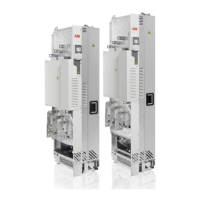5. Route the control cables along the control cable duct from bottom or top to the
control unit.
6. Ground the shields of the control cables at the clamp plate. The shields should be
continuous as close to the terminals of the control unit as possible. Only remove
the outer jacket of the cable at the cable clamp so that the clamp presses on the
bare shield. The shield (especially in case of multiple shields) can also be terminated
with a lug and fastened with a screw at the clamp plate. Leave the other end of
the shield unconnected or ground it indirectly through a few nanofarads
high-frequency capacitor, for example, 3.3 nF / 630 V. The shield can also be
grounded directly at both ends if they are in the same ground line with no
significant voltage drop between the end points. Tighten the screws to secure
the connection.
7. Connect the conductors to the appropriate detachable terminals of the control
unit. See chapter Control unit (page 135) for the default I/O connections of the
drive module. Use shrink tubing or insulating tape to contain any stray strands.
Tighten the screws to secure the connection.
Keep any signal wire pairs twisted as close to the terminals as possible. Twisting
the wire with its return wire reduces disturbances caused by inductive coupling.
8. Install the middle front cover back.
■ External control unit (option +P906)
Connect the external conductors to the external control unit and the control unit to
the drive module as instructed in chapter External control unit (option +P906) (page 147).
Connecting a control panel
With control panel door mounting platform, connect the control panel as follows:
1. Connect an Ethernet cable to the RJ-45 connector of the control panel.
2. Connect the other end of the cable to the panel port (X12) of the control unit.
108 Electrical installation

